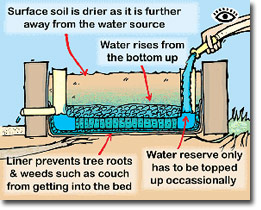By Sandra Tuszynska

Wicking Bed. Retrieved from http://tamuhowdyfarm.weebly.com/blog
Most of us find it too time consuming to have a garden. We are used to seeing gardening as something laborious, and which takes time to water and weed. So imagine a garden design where these tasks are reduced to a minimum, where the garden remains watered for potentially a months or longer at a time, and the watering takes no more than a minute, or potentially no time at all. Imagine a garden which you don’t have to weed.? If this is your idea of gardening, then water-less or wicking bed gardening is for you. However, it is not going to sprout out magically, you still need to put some effort into creating it, but that will be potentially the only large effort you will put in, the initial set up of the garden.

Wicking Worm- Bed. Retrieved from http://www.sgaonline.org.au/worm-wicking-one-year-on/
The Principles of a Wicking-Bed Garden
The idea of a wicking bed is to create a water holding reservoir at the bottom of the bed for water to travel up, or wick up by the soil. Most soils on average have the capacity to wick water up to a height of about 30 cm, but this varies with soil used.

Image retrieved from https://thesoilhuggersjourney.wordpress.com/2015/03/18/planting-in-spring-surviving-through-summer-wicking-bed-summer-follow-up-did-we-survive/
Water is essentially delivered into the water reservoir via a pipe, while the bed is drained through an overflow pipe just above the reservoir. The beauty of the design, is that it minimises water loss completely, the only water that is lost is through plant transpiration, as the soil is heavily mulched. This also helps to reduce weed growth to potentially zero.

Watering from bottom up. Image retrieved from http://peterdilley.tumblr.com/page/3
Peter’s Permaculture Scrap-Book, From Bottom Up – DIY Guide to Wicking Beds is a great resource, explaining the principles of capillary action of water as well as the different designs of wicking beds and how to create them.
Creating a Wicking Bed
There are now countless designs of wicking beds that people have experimented with over the years. The main requirement is to create a durable reservoir containment, and people use anything from polythene, plastic tubs, to concrete. This reservoir can be as deep or shallow as you like it to be. However, the deeper it is, obviously the longer the supply of water in it, and therefore the less frequent need for watering the bed.

Image retrieved from http://www.backyardaquaponics.com/forum/viewtopic.php?f=18&t=23402
This wicking bed design is from SOP’s IBC Wicking Beds site, which has step by step images and descriptions of how how to create it.

Final outcome, image retrieved from http://www.backyardaquaponics.com/forum/viewtopic.php?f=18&t=23402
I have created small wicking beds in Styrofoam broccoli boxes, an in-ground bed and an above-ground bed within a wooden frame. Polythene is prone to leaking and this is a major issue which can be avoided by creating a solid containment using concrete. This however is time consuming and could be expensive, depending on the size of the bed you want to create. I am lazy, I don’t want to spend too many hours on projects at the moment so small wicking gardens in containers, barrels or drums are the way to go for me.

Image retrieved from https://www.flickr.com/photos/cicada/5454681453/
Being relatively small, these can be used on balconies and in small gardens or back yards.

Image retrieved from http://lockyervalley.org/category/wicking-beds-pots/
My friend John, on the other hand puts in a lot of effort in to designing and creating wicking beds. His favourite model is a horseshoe–shaped, walk-in, above-ground bed made of concrete and recycled iron sheets. In the very centre is a 200 litre drum with a mulberry tree to provide summer shade. He completely automated the water delivery into the reservoir, by connecting it to a toilet cistern valve and directly onto a water tank. The idea is to keep the water level in the reservoir constant, when plants take up water, and water levels drop, the valve automatically opens and replenishes it.
Course River Sand is the Best
From all the research I have seen, the best water reservoir material seems to be course river sand. People use soil too, the only problem might be that it is likely for the water to become stagnant and putrid, because of the biological matter in soil.
In all I love the wicking bed design and it’s practicality, even if it initially requires some time and effort to set up, it is truly the most logical garden design in terms of water usage and time saving. This is especially important in drought prone areas.
A Few Good Sites for Ideas, Designs and Deeper Research
All about wicking beds:
http://www.waterright.com.au/wicking_bed_technology.pdf
Wicking bed with embedded worm farm experiment:









